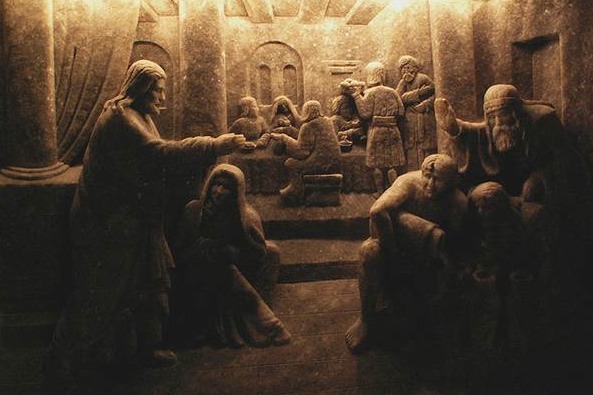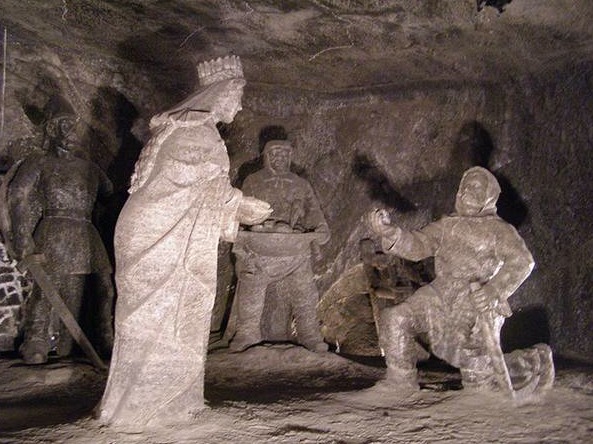From the outside, Wieliczka Salt Mine doesn’t look extraordinary. It looks extremely well kept for
a place that hasn’t mined any salt for over ten years but apart from that it looks ordinary. However,
over six hundred feet below ground it holds an astonishing secret.
This is the salt mine that became an art gallery, cathedral and underground lake. Situated in the Krakow area, Wieliczka is a small town of close to twenty thousand inhabitants. It was founded in the twelfth century by a local Duke to mine the rich deposits of salt that lie beneath. Until 1996 it did just that, but the generations of miners did more than just extract. They left behind them a breathtaking record of their time underground in the shape of statues of mythic, historical and religious figures. They even created their own chapels in which to pray. Perhaps their most astonishing legacy is the huge underground cathedral they left behind for posterity.
It may feel like you are in the middle of a Jules Verne adventure as you descend in to the depths of the world. After a 180 foot climb down wooden stairs, the visitor to the salt mine will see some amazing sites. About the most astounding in terms of its sheer size and audacity is the Chapel of Saint Kinga. The Polish people have for many centuries been devout Catholics and this was more than just a long term hobby to relieve the boredom of being underground. This was an act of worship.
Amazingly, even the chandeliers in the cathedral are made of salt. It was not simply hewn from the ground and then thrown together; however, the process is rather more painstaking for the lighting. After extraction, the rock salt was first of all dissolved. It was then reconstituted with the impurities taken out so that it achieved a glass-like finish. The chandeliers are what many visitors think the rest of the cavernous mine will be like as they have a picture in their minds of salt as they would sprinkle on their meals! However, the rock salt occurs naturally in different shades of grey (something like you would expect granite to look like).
Still, that doesn't stop well over one million visitors (mainly from Poland and its eastern European neighbors) from visiting the mine to see, amongst other things, how salt was mined in the past.
For safety reasons less than one percent of the mine is open to visitors, but even that is still almost four kilometers in length – more than enough to weary the average tourist after an hour or two. The mine was closed for two reasons – the low price of salt on the world market made it too expensive to extract here. Also, the mine was slowly flooding – another reason why visitors are restricted to certain areas only.
The religious carvings are, in reality, what draw many to this mine – as much for their amazing verisimilitude
as for their Christian Aesthetics. The above shows Jesus appearing to the apostles after the Crucifixion. He shows the doubter, Saint Thomas, the wounds on his wrists.
Another remarkable carving, this time a take on The Last Supper. The work and patience that must have gone into the creation of these sculptures is extraordinary. One wonders what the miners would have thought of their work going on general display? They came to be quite used to it, in fact, even during the mine’s busiest period in the nineteenth century, the cream of Europe’s thinkers visited the site – you can still see many of their names in the old visitor's books on display.
Not all of the work is relief-based. There are many life sized statues that must have taken a considerable amount of time – months, perhaps even years – to create. Within the confines of the mine there is also much to be learned about the miners from the machinery and tools that they used – many of which are on display and are centuries old. A catastrophic flood in 1992 dealt the last blow to commercial salt mining in the area and now the
mine functions purely as a tourist attraction. Brine is, however, still extracted from the mine – and then evaporated to produce some salt, but hardly on the ancient scale. If this was not done, then the mines would soon become flooded once again.
mine functions purely as a tourist attraction. Brine is, however, still extracted from the mine – and then evaporated to produce some salt, but hardly on the ancient scale. If this was not done, then the mines would soon become flooded once again.
Not all of the statues have a religious or symbolic imagery attached to them. The miners had a sense of humor, after all! Here can be seen their own take on the legend of Snow White and the Seven Dwarfs. The intricately carved dwarfs must have seemed to some of the miners a kind of ironic depiction of their own work.
To cap it all there is even an underground lake, lit by subdued electricity and candles. This is perhaps where the old legends of lakes to the underworld and Catholic imagery of the saints work together to best leave a lasting impression of the mine. How different a few minutes reflection here must have been to the noise and sweat of everyday working life in the mine.
Fun
Somewhat in keeping with the above, we have --
BIBLE STORIES
HIGHER POWER
A Sunday school teacher said to her children, "We have been learning how powerful kings and queens were in bible times. But, there is a higher power. Can anybody tell me what it is?" One child blurted out, "Aces!" 












W O W.
ReplyDeleteAlison said it first.
ReplyDeleteI want to visit, but now I feel like some pretzels.
Amazing and lovely!
ReplyDelete